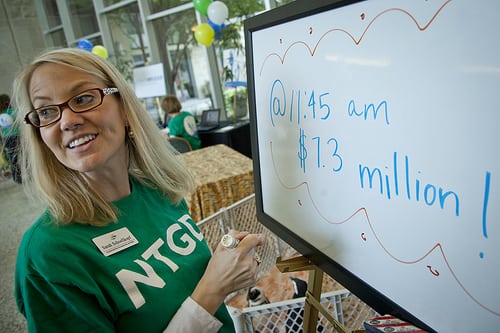 4 Big Things You Need To Do Now To Prepare A Successful “Giving Day”
4 Big Things You Need To Do Now To Prepare A Successful “Giving Day”
by Beth Kanter and Bahia Ramos
We’re glad to welcome back two previous contributors to Markets For Good: Beth Kanter (Doing The Math Ourselves) and Bahia Ramos (Methods & Tools For ‘Giving Days'”). Having spent the prior month exploring the topic of fundraising, we take this opportunity to round out that conversation with a “how-to.” This post was originally published on Knight Blog, the blog of the John S. and James L. Knight Foundation. (Photo Credit Flickr User, Communities Foundation of Texas)
…
So, you want to start a Giving Day.
That’s something we have heard more and more over the last year, as foundations and nonprofits look for ways to tap into the growing online giving market with these daylong campaigns raising funds for local causes.
They can seem overwhelming—months of planning, untold hours of staff time, culminating in a 24-hour or longer sprint. But they don’t have to be. Today, Knight Foundation published a new Giving Day Playbook, which breaks down the whole process from Day One of planning to launch and post-campaign analysis. The best part of the Playbook is that it is full of checklists and templates from the community foundations that in recent years have experimented with these campaigns, often with great success. With tips for any nonprofit participating in or launching a campaign, the playbook not only tells you how to set a Giving Day budget and allot staff time, but also how to use the power of social media to reach new donors.
The guide, written by online fundraising experts at Third Plateau and KDS Strategies, is Knight Foundation’s way of sharing emerging best practices as organizations continue to experiment with engaging communities online. We’ll be hosting a webinar with CommA on planning giving days too at 2 p.m. ET Sept. 12. (Registration is here.)
As we head into the year’s big Giving Day season, we wanted to share four big things you need to do now to prepare a successful campaign:
#1: Set explicit, measurable goals, so you know what success looks like.
Giving Days aren’t just about dollars raised—though they certainly can bring in lots of cash for worthy causes. They also can be a great tool for a whole range of goals, including reaching out to new donors, expanding a community foundation’s profile or helping nonprofits learn to use digital tools. Your goal will depend on your organization’s individual circumstances, but here’s what others have done:
The Park City Community Foundation’s Live PC Give PC campaign, for example, has increased the foundation’s engagement in the community, with the campaign participating in local events and remaining active on social media.
The 2011 Greater Washington Give to the Max Day successfully built capacity in local nonprofits, with 84 percent of nonprofit survey respondents reporting that the Giving Day training sessions increased their ability to interact and fundraise online.
Set the right goal, and it makes it much easier to….
#2: Pick the right target audience
It is tempting to think that your target audience is “everyone.” (After all, won’t everyone love your campaign!) However, many Giving Day organizers smartly narrow their focus to certain nonprofit and/or donor segments—informed by the goal they have set. In looking for nonprofit partners that will both seek and accept donations on that day, they might include organizations with budgets under a certain size, groups working on certain issues, or groups located in a particular part of your community. For donors, you might seek to include young donors, donors with a certain capacity level or those with a history of supporting a particular issue area.
The Giving Day Playbook includes checklists, templates and examples to put together a comprehensive community marketing plan that can help a community foundation reach its target audience and goals.
#3: Pick the structure that best fits your capacity and goals
Some Giving Days are single days, others last a week or even a month. Some are stand-alone efforts in their communities, like Give Miami Day benefitting Greater Miami, while others are connected to a statewide campaign like the Georgia Gives campaign. They can be open to the entire nonprofit community—or a certain segment of nonprofits.
There is no one “right” or ideal structure for a Giving Day. The answer depends on the organization’s goals.
#4: Begin planning…now
Giving Days are the culmination of a great deal of hard work, partnerships between a number of organizations and a big, coordinated outreach effort. None of this can be done effectively without systematic planning upfront. The greatest difference between very successful and less successful Giving Days is the time and thought that goes into the planning phase. Detailed, strategic plans at the outset make it far more likely that everyone and everything will move in concert on the big day. The playbook includes a Sample Six-Month Planning Timeline to help you get started. You can also use these checklists for what to do six, five months, four months, one month and one week out from Giving Day.
There’s much more online in the Giving Day Playbook that can help get you started.
If your foundation has hosted a Giving Day, what do you think are the most important first planning steps?
…
Beth Kanter is a communications strategist and author of the popular Beth’s Blog: How Nonprofits Can Use Social Media
Bahia Ramos is the director of Knight Foundation’s communication foundations program
